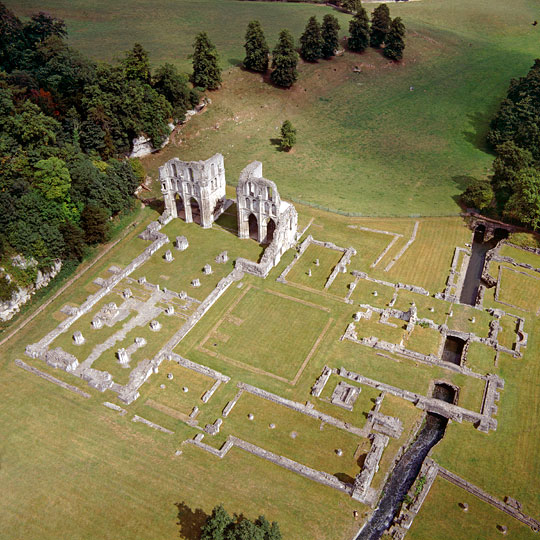Significance of Roche Abbey
The church of Roche Abbey is an outstanding example of early Gothic architecture in England, and the gatehouse is one of the earliest to survive from a Cistercian monastery. Roche’s later history is equally significant: a surviving account of the abbey’s suppression is one of the most important sources describing a monastery’s destruction, while in the 18th century ‘Capability’ Brown’s landscaping was his first attempt to create a Picturesque historic ruin.

The Cistercians
Many of the Cistercians’ eight monasteries in Yorkshire were large, such as Rievaulx with more than 600 men, and Fountains and Byland with over 250. In contrast, Roche’s moderate size (150 men at its peak) is a more typical example of the order’s monasteries.
Most Cistercian abbeys in Yorkshire extended their church and other buildings to reflect new liturgical developments or more fashionable styles. Roche’s restraint and conservatism is reflected in its layout, which retains many features original to the Cistercians’ English monasteries in their prime and thus reflects the intentions of the founders of the order. It also explains why Roche is often used as a paradigmatic example of the first, brilliant stage of the Cistercians’ expansion.
Early Gothic Architecture
The church is an outstanding example of early Gothic architecture. This style, introduced in the area around Paris in the mid-1140s, united single structural features (such as pointed arches or rib vaults), sought increased light from larger windows, enlarged spatial volumes and displayed more unified decoration.
The first Cistercian buildings in England to use the early Gothic style, in the late 1160s and 1170s, are at Kirkstead in Lincolnshire and Newminster in Northumberland (the ‘mother’ or founding house of Roche). The precisely cut stone and elaborate decoration at Roche, which is slightly later in date, also suggest contact with Cistercian centres in eastern France, notably Clairvaux (Aube) and Cherlieu (Franche-Comté), and with the abbeys of related orders in north-east France such as the Premonstratensian priory of Dommartin (Nord Pas-de-Calais).
The Gothic form of Roche contrasts with the architecture of the Cistercians’ earlier English monasteries, such as Rievaulx, Fountains, Kirkstall and Sawley, which employed Romanesque architecture marked by heavy piers and mouldings, strong massing, decorative detailing and wooden vaults.
Changes in Use
Roche’s need to adapt in the decades following the departure of the lay brothers after 1300 is best observed in the rebuilding of the great gatehouse. While still accommodating Cistercian obligations towards hospitality and the administration of charity, the new gatehouse also reflects trends tied to the withdrawal of direct labour (provided by the lay brothers) on the granges and sheep pastures and its replacement by tenant farmers.
This development drew the monastery into the negotiations of rentals, and inevitable disputes over trespass and land administration. Such legal entanglements were decided by the abbot in the rooms above the entrance in other monasteries, and this may also have been the case in the great gatehouse at Roche.
Account of the Suppression
The suppression of Roche Abbey in 1538 was vividly recorded 30 years after the event by Michael Sherbrook (1535–1610), a rector of the nearby parish of Wickersley. The events he described took place when he was a child and were related to him by his father and uncle.
Although some items were sold through public auction after the official surrender of the abbey, a local mob descended on the monastery and stole what it could. ‘It would have pitied any heart’, Sherbrook’s father said, ‘to see the tearing up of the lead … it seemed that every person bent himself to filch and spoil what he could.’[1]
Sherbrook’s account of the Suppression is the most complete from any religious institution in England.
‘Capability’ Brown’s Landscape
The central episode in the post-Suppression history of Roche remains the work of Capability Brown in the 1770s, making the ruins a feature in a designed landscape (see History of Roche Abbey). He levelled off the west parts of the church and inner court and covered them with grass to create a verdant foreground to the Picturesque tableau seen from the banqueting lodge.
READ MORE ABOUT ROCHE ABBEY
Footnotes
1. Transcribed in AG Dickens (ed), Tudor Treatises, Yorkshire Archaeological Record Series 125 (Wakefield, 1959), 123–6.
